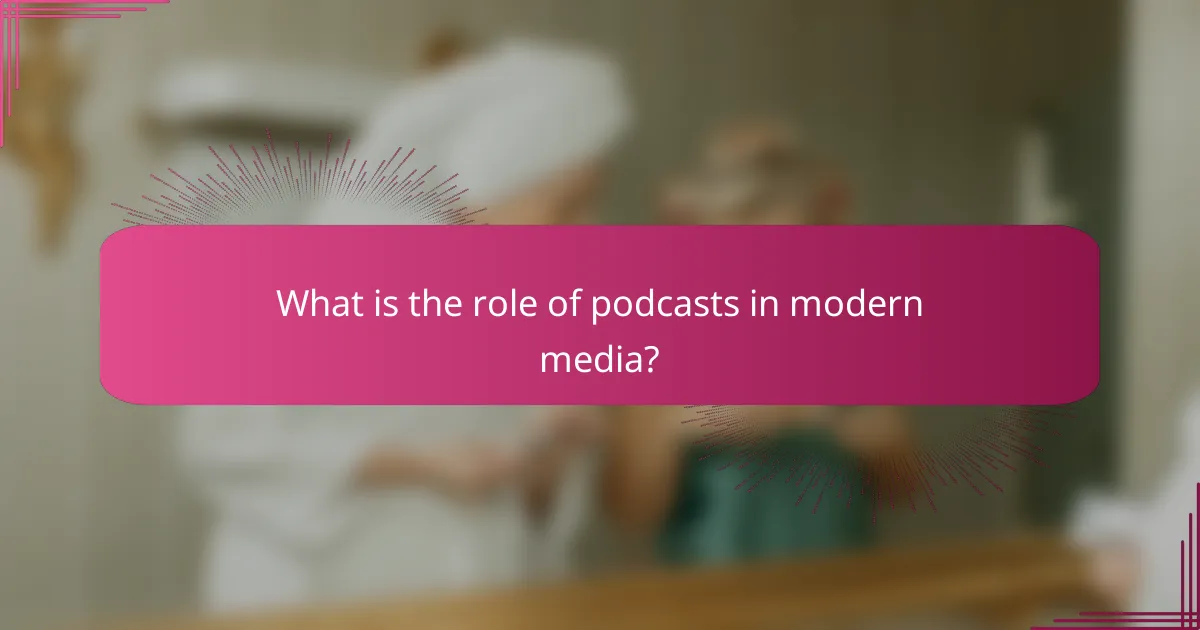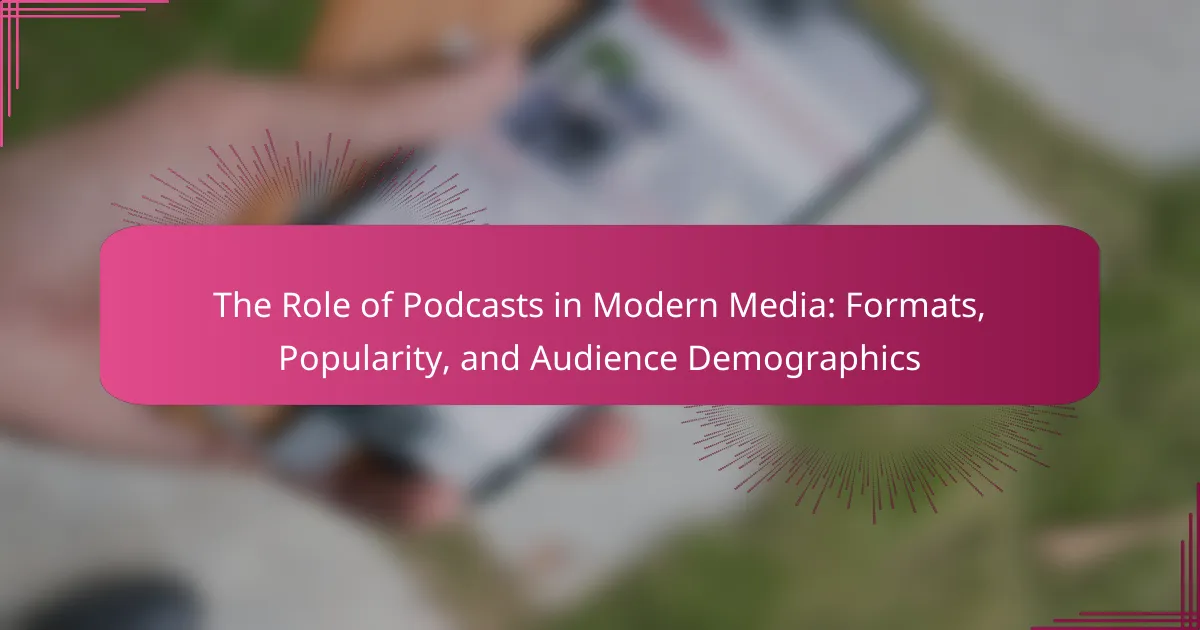Podcasts are a prominent entity in modern media, offering accessible audio content across various formats, including interviews, storytelling, and educational series. Their popularity has significantly increased, with over 750,000 active shows reported in 2021, driven by the demand for on-demand content that aligns with listeners’ busy lifestyles. The audience for podcasts is diverse, with key demographics including millennials and Gen Z, as well as professionals seeking knowledge and entertainment. Additionally, podcasts foster community engagement and niche content creation, allowing underrepresented voices to be heard. The advertising market for podcasts has also expanded, generating substantial revenue and underscoring their importance in the media landscape.

What is the role of podcasts in modern media?
Podcasts play a significant role in modern media by providing accessible audio content. They offer diverse formats, including interviews, storytelling, and educational series. This variety caters to different audience preferences and interests. The popularity of podcasts has surged, with over 750,000 active shows available as of 2021. This growth reflects the increasing demand for on-demand content that fits into listeners’ busy lifestyles. Podcasts also foster community engagement and discussion around various topics. They enable niche content creation, allowing underrepresented voices to share their stories. Additionally, advertising in podcasts has become a lucrative market, generating billions in revenue. This financial aspect further solidifies their importance in the media landscape.
How have podcasts evolved in the media landscape?
Podcasts have evolved significantly in the media landscape. Initially, they were niche audio files available for download. Over time, they transitioned into a mainstream medium with diverse content. By 2021, there were over 2 million podcasts available globally. This growth reflects a surge in listener interest, with over 100 million Americans tuning in monthly. Major media companies have invested heavily in podcasting, acquiring popular shows and launching original content. The evolution also includes advancements in technology, making it easier for creators to produce and distribute podcasts. Additionally, the rise of mobile devices has facilitated on-the-go listening. These changes have positioned podcasts as a key player in the broader media ecosystem.
What technological advancements have influenced podcasting?
Technological advancements have significantly influenced podcasting. The rise of high-speed internet has enabled seamless streaming and downloading of audio content. Mobile devices, particularly smartphones, have made podcasts easily accessible anywhere. Podcast hosting platforms, such as Libsyn and Podbean, have simplified content distribution for creators. RSS feeds have automated the delivery of new episodes to subscribers. Audio editing software, like Audacity and GarageBand, has improved production quality for podcasters. Social media integration allows for effective promotion and audience engagement. Voice-activated assistants, such as Alexa and Google Assistant, have increased podcast discoverability. These advancements have collectively shaped the podcasting landscape, enhancing both creator capabilities and listener experiences.
How do podcasts compare to traditional media formats?
Podcasts differ from traditional media formats in their accessibility and engagement. Unlike radio or television, podcasts allow on-demand listening. This flexibility accommodates diverse schedules and preferences. Podcasts can be consumed anytime and anywhere, making them convenient. Traditional media often requires viewers to adhere to specific broadcast times. The audience for podcasts is also more niche, targeting specific interests. According to Edison Research, 55% of Americans have listened to a podcast, indicating significant reach. Additionally, podcasts foster a sense of intimacy, as hosts often speak directly to listeners. This personal connection is less prevalent in traditional media formats. Overall, podcasts provide unique advantages in accessibility, niche targeting, and audience engagement.
Why are podcasts becoming increasingly popular?
Podcasts are becoming increasingly popular due to their convenience and accessibility. They allow listeners to consume content while multitasking, such as during commutes or workouts. The growth of smartphone usage has made podcast consumption easier than ever. According to Edison Research, 55% of the U.S. population has listened to a podcast, up from 51% in 2020. Additionally, the variety of topics available caters to diverse interests. This broad range attracts a wide audience, from true crime enthusiasts to business professionals. The intimate format of podcasts fosters a personal connection between hosts and listeners. As a result, engagement levels tend to be higher compared to other media forms.
What factors contribute to the rise in podcast listenership?
The rise in podcast listenership is driven by several key factors. Increased smartphone usage facilitates easy access to podcasts. A diverse range of topics attracts a broad audience. The convenience of on-demand listening fits modern lifestyles. Improved audio quality enhances the listening experience. Social media promotion boosts visibility and discoverability. Data from Edison Research indicates that 41% of Americans aged 12 and older have listened to a podcast in the past year. This reflects a steady growth trend in podcast engagement.
How do podcasts engage audiences differently than other media?
Podcasts engage audiences differently than other media through their unique format and accessibility. They allow for intimate, on-the-go listening experiences. This format fosters a personal connection between hosts and listeners. Additionally, podcasts can be consumed while multitasking, unlike traditional media. Research shows that 54% of podcast listeners report feeling more connected to hosts than with other media formats. The episodic nature encourages regular engagement and loyalty. Furthermore, podcasts often feature niche topics that attract dedicated audiences. This targeted content enhances listener investment and community building.

What are the different formats of podcasts?
Podcasts exist in several formats, each catering to different audience preferences. The most common format is the interview style, where hosts converse with guests. Narrative storytelling is another popular format, presenting a story or theme over multiple episodes. Educational podcasts focus on teaching specific subjects or skills. Roundtable discussions feature multiple hosts discussing various topics. Solo podcasts consist of a single host sharing personal insights or experiences. Additionally, scripted fiction podcasts deliver original audio dramas. Each format serves unique listener interests and engagement levels.
What are the most common podcast formats available?
The most common podcast formats available include interviews, panel discussions, storytelling, and solo commentary. Interview formats involve a host speaking with guests to share insights. Panel discussions feature multiple guests discussing a topic together. Storytelling podcasts focus on narrative-driven content, often with a singular theme. Solo commentary involves a host sharing their thoughts and opinions on various subjects. These formats cater to diverse audience preferences and enhance engagement.
How do narrative podcasts differ from interview-style podcasts?
Narrative podcasts tell stories with a structured format, while interview-style podcasts feature conversations between hosts and guests. Narrative podcasts often use scripted content, sound design, and editing to create immersive experiences. They focus on delivering a cohesive storyline, often exploring a single theme or concept over multiple episodes. In contrast, interview-style podcasts prioritize spontaneous dialogue and personal insights from guests. They may cover a wide range of topics in each episode, depending on the guest’s expertise. This format allows for more varied content but less narrative cohesion. Research shows that narrative podcasts can engage listeners for longer durations due to their storytelling elements.
What role do scripted and unscripted formats play in podcasting?
Scripted and unscripted formats play distinct roles in podcasting. Scripted podcasts often provide a structured narrative. This format can enhance storytelling and ensure clarity. It allows for precise delivery of information and well-crafted dialogue. Many popular scripted podcasts, like “Welcome to Night Vale,” exemplify this approach.
Unscripted podcasts, on the other hand, offer spontaneity and authenticity. They encourage natural conversations and unscripted moments. This format can create a sense of intimacy and relatability. Popular examples include “The Joe Rogan Experience,” which thrives on open dialogue.
Both formats cater to different audience preferences. Scripted formats appeal to listeners seeking polished content. Unscripted formats attract those who enjoy candid discussions. The diversity of formats enriches the podcasting landscape.
How does podcast length impact listener engagement?
Podcast length significantly impacts listener engagement. Research shows that shorter podcasts, typically under 20 minutes, tend to retain listeners better. According to a study by Edison Research, 75% of podcast listeners prefer episodes that are 20 minutes or less. Longer podcasts, often exceeding 60 minutes, may result in higher drop-off rates. Engagement metrics indicate that episodes around 30 minutes strike a balance, keeping listeners interested without overwhelming them. Additionally, the context of the listener’s activity, such as commuting or exercising, influences their preference for podcast length. Thus, understanding these trends can help creators optimize episode durations for better engagement.
What is the ideal duration for a podcast episode?
The ideal duration for a podcast episode is typically between 20 to 60 minutes. Episodes within this range cater to audience preferences for digestible content. Research shows that 22 minutes is the average length for popular podcasts. This duration allows for in-depth discussions without losing listener engagement. Longer episodes may lead to decreased retention rates. Shorter formats can limit the depth of the topic covered. Overall, 20 to 60 minutes is widely accepted as the sweet spot for podcast episodes.
How does episode frequency affect audience retention?
Higher episode frequency generally increases audience retention. Regularly releasing episodes keeps the content fresh in listeners’ minds. This frequent engagement fosters a sense of routine among the audience. A study by Podtrac found that podcasts releasing episodes weekly had a 20% higher retention rate than those with monthly releases. Consistency in episode frequency builds listener loyalty. Audiences are more likely to stay engaged when they know when to expect new content. This pattern reinforces ongoing interest and habit formation. Overall, episode frequency plays a critical role in maintaining and growing an audience.

Who are the audiences for podcasts?
Podcasts attract diverse audiences. Key demographics include millennials and Gen Z, who favor on-demand content. Research shows that 54% of podcast listeners are between 18 and 34 years old. Additionally, many listeners are professionals seeking knowledge and entertainment during commutes. The audience also includes niche groups interested in specific topics like health, technology, and true crime. Data indicates that 75% of Americans are familiar with podcasting, highlighting its broad reach. Furthermore, 80% of podcast listeners listen to all or most episodes of a series, indicating strong engagement.
What demographics are most likely to listen to podcasts?
Younger adults aged 18 to 34 are the demographics most likely to listen to podcasts. According to the Edison Research 2021 Infinite Dial report, 50% of this age group listens to podcasts monthly. Additionally, the same report indicates that podcast consumption is higher among individuals with higher education levels. Urban residents also show a greater tendency to engage with podcasts compared to rural populations. Gender-wise, men are slightly more likely to listen than women, with 55% of male respondents indicating regular podcast listening. These statistics highlight the significant interest in podcasts among younger, educated, and urban populations.
How do age and gender influence podcast preferences?
Age and gender significantly influence podcast preferences. Younger audiences tend to favor genres like comedy and true crime. Older listeners often prefer news and educational content. Gender also plays a role in preferences. Women are more likely to listen to lifestyle and health-related podcasts. Men tend to gravitate towards sports and technology themes. Research from Edison Research indicates that 50% of women prefer podcasts about health, while 40% of men enjoy technology-focused shows. These trends highlight the distinct listening habits shaped by age and gender demographics in podcast consumption.
What are the listening habits of podcast audiences?
Podcast audiences typically listen to episodes during commutes, workouts, or while performing household tasks. Research shows that 55% of podcast listeners tune in while driving. Additionally, 43% listen during exercise sessions. Many listeners prefer longer episodes, often ranging from 20 to 60 minutes. A significant portion, around 80%, listens to the entire episode. This high completion rate indicates strong engagement. Furthermore, listeners often subscribe to multiple shows, averaging about seven podcasts each. The convenience of on-demand audio contributes to these habits. Studies reveal that 49% of listeners enjoy discovering new podcasts through recommendations.
How do audience demographics affect podcast content?
Audience demographics significantly influence podcast content. Different age groups prefer varied topics and styles. For instance, younger audiences may favor pop culture and technology discussions. Conversely, older demographics often engage with history and lifestyle content. Gender also plays a role; women may prefer storytelling and personal development themes.
Cultural backgrounds shape content preferences as well. Diverse audiences appreciate representation in topics and hosts. This leads to tailored content that resonates more with specific groups. Data shows that podcasts with niche topics attract dedicated listener bases.
In summary, understanding audience demographics helps creators produce relevant and engaging podcast content.
What topics resonate with different audience segments?
Different audience segments resonate with topics that align with their interests and demographics. For example, younger audiences often prefer topics related to technology and pop culture. In contrast, older listeners may gravitate towards health, finance, or personal development.
Research indicates that niche topics attract dedicated listeners. A study by Edison Research found that true crime podcasts have a strong following among both men and women, particularly in the 18-34 age range. Similarly, business and entrepreneurship topics resonate well with professionals seeking growth and knowledge.
Moreover, audiences interested in storytelling appreciate narrative-driven content. This format can engage listeners across various demographics. Ultimately, understanding audience preferences is crucial for content creators in the podcasting landscape.
How can podcasters tailor content to specific demographics?
Podcasters can tailor content to specific demographics by understanding their audience’s preferences and interests. This involves conducting audience research to identify key characteristics such as age, gender, location, and interests. Analyzing listener feedback and engagement metrics also helps in refining content. Utilizing social media platforms to interact with listeners can provide insights into their preferences. Additionally, creating content that resonates with specific cultural or regional contexts enhances relatability. For example, a podcast targeting millennials might focus on trending topics in technology and lifestyle. By aligning content with the values and interests of the target demographic, podcasters can increase listener engagement and retention.
What are some best practices for engaging podcast audiences?
Engaging podcast audiences involves several best practices. First, create compelling content that resonates with listeners. Research shows that storytelling significantly enhances listener retention. Second, maintain a consistent release schedule. Data indicates that regular episodes build audience expectations and loyalty. Third, interact with your audience through social media. Engagement on platforms like Twitter and Instagram fosters community and feedback. Fourth, encourage listener participation. Surveys and Q&A segments can increase audience investment. Fifth, use high-quality audio production. Studies find that poor sound quality can lead to listener drop-off. Lastly, feature guest interviews to provide diverse perspectives. This approach can attract new listeners and enrich content.
Podcasts are a significant entity in modern media, offering accessible audio content across various formats such as interviews, storytelling, and educational series. The article examines the evolution of podcasts, highlighting their rise in popularity driven by technological advancements and changing listener habits. It explores the diversity of podcast formats, audience demographics, and the factors contributing to listener engagement, including episode length and frequency. Additionally, the content emphasizes how understanding audience preferences can enhance podcast creation and community engagement.
